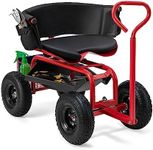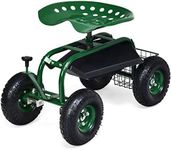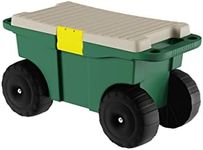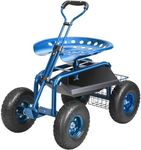Buying Guide for the Best Rolling Garden Seat
Choosing a rolling garden seat can make gardening much more comfortable and efficient, especially if you spend a lot of time working close to the ground. The right seat can help reduce strain on your knees and back, and make it easier to move around your garden. When picking a rolling garden seat, it's important to consider how you'll use it, the type of terrain in your garden, and your own comfort needs. Understanding the key features will help you find a seat that fits your gardening style and physical requirements.Weight CapacityWeight capacity refers to the maximum weight the seat can safely support. This is important because using a seat that can't handle your weight could lead to breakage or injury. Rolling garden seats typically have weight limits ranging from around 200 to 400 pounds. If you are on the lighter side, most seats will work for you, but if you need extra support, look for a higher weight capacity. Always choose a seat that comfortably exceeds your own weight for safety and durability.
Seat HeightSeat height is the distance from the ground to the top of the seat. This matters because it affects how easy it is to reach your plants and how comfortable you are while sitting. Lower seats (around 12-16 inches) are better for tasks close to the ground, like weeding, while higher seats (18-22 inches) are more comfortable for working with raised beds or larger plants. Consider the type of gardening you do most often and your own mobility when choosing the right height.
Wheel Type and SizeThe wheels on a rolling garden seat determine how easily it moves over different surfaces. Larger wheels (8 inches or more) are better for rough or uneven terrain, while smaller wheels work well on smooth patios or lawns. Some wheels are made of plastic, which is lightweight but may not last as long, while rubber or pneumatic (air-filled) wheels offer better grip and comfort. Think about your garden's surface and choose wheels that will roll smoothly where you need them.
Frame MaterialFrame material affects the seat's durability, weight, and resistance to weather. Common materials include steel, aluminum, and heavy-duty plastic. Steel is strong and stable but can be heavy and may rust if not coated. Aluminum is lighter and rust-resistant but may not be as sturdy. Plastic is lightweight and won't rust, but may not hold up as well under heavy use. Choose a material that balances strength and weight for your needs, and consider how much you'll be moving the seat around.
Storage FeaturesMany rolling garden seats come with built-in storage, such as trays or baskets, for holding tools and supplies. This feature is important if you want to keep your gardening tools within easy reach while you work. Some seats have removable trays, while others have fixed baskets underneath. If you use a lot of tools or like to keep things organized, look for a seat with ample and accessible storage.
AdjustabilitySome rolling garden seats offer adjustable features, such as seat height or backrests. Adjustability is important if you want to customize the seat for different tasks or users. If you share the seat with others or do a variety of gardening activities, an adjustable seat can provide more comfort and flexibility. If you have specific comfort needs, look for seats with adjustable options.













